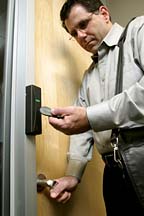FYI on RFID

An RFID system consists of three main components: antenna, transceiver (usually combined into one reader) and a transponder (tag). The antenna employs RF waves to transmit a signal that activates the transponder. When activated, the tag sends data back to the antenna. The data is used to notify a programmable logic controller that some form of action should occur. This action could be as simple as opening an access point, such as a door or gate, or as complicated as interfacing with a database to carry out a payment transaction.

Standards define
There are various standards organizations covering RFID. The main standards bodies are the International Standards Organization (ISO) and EPC Global, which grew out of MIT and the Auto-ID Center. The ISO standards define the frequency spectrum allocation and cover such things as identification cards and animal identification. EPC Global has the specific focus of developing standards that will allow identification of goods to improve efficiencies for manufacturing, marketing and logistics on a global scale.
Low-frequency RFID systems (30 KHz to 300 KHz) have short transmission ranges (generally a few inches to a few feet). High-frequency RFID systems (3 MHz to 30 MHz) also typically have short transmission ranges. UHF or ultra-high frequency RFID (300 MHz to 1000 MHz) offers longer transmission ranges (several feet to more than 90 feet). The microwave frequencies (1 GHz and above) also provide very long transmission ranges (several hundred feet or more).
In the access control industry, examples of common forms of RFID include low-frequency proximity products (prox cards and readers) operating at 125 KHz, and high-frequency contactless smart card products operating at 13.56 MHz. Examples of common UHF implementations are 433 MHz long-range products for parking collection and 900-MHz long-range products such as cordless telephones. There are also EPC UHF products competing for business in retail, government and supply chain implementations. Microwave products at 2.4 GHz are used for applications such as highway toll collection and wireless networks.
EAS, or electronic article surveillance, is another common use of RFID, typically seen in anti-theft products at the exits of retail or department store establishments. Recently, RFID in the form of contactless smart cards have been used for contactless payment or point-of-sale applications (e.g. the MasterCard PayPass). Most of the major credit card companies have some initiative for the use of contactless payment tokens.

On-job terms
While all of the aforementioned technologies are considered RFID, there are various terms used in industry, which have developed specific meaning through use over a period of years. For instance, the term RFID has recently become synonymous with the use of RFID tags on product packaging for supply chain logistics. This application for retail (Wal-Mart) and industrial use has dominated the press. These RFID products are compliant with standards from EPC Global.The term proximity is a bit more problematic. In North America, proximity technology typically means prox cards and prox readers because these 125 KHz products became the defacto standard for access control systems during the 1990s. However, the ISO standards define the ISO14443 13.56 MHz standard as proximity. ISO also defined the ISO15693 13.56 MHz standard as vicinity.
The term contactless has become synonymous with 13.56-MHz contactless smart cards, to cover both proximity and vicinity standards. Mifare, ISO-X, my-d, iCLASS and Tag-it are all examples of contactless technologies.
Sidebar: 411 on RFID
With the world becoming more and more wireless, RFID technology and its various meanings and applications are here to stay. Some resources that may be helpful in learning more about RFID include www.aimglobal.org, www.rfidjournal.com, www.contactlessnews.com and www.rfidnews.com.More information the security uses of RFID is available through the Security magazine Web site. At the opening page, use the LINX service, powered by Google. Just enter in your appropriate keywords, choose Security in the drop-down menu and search.
Looking for a reprint of this article?
From high-res PDFs to custom plaques, order your copy today!


